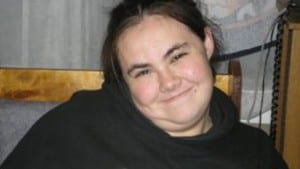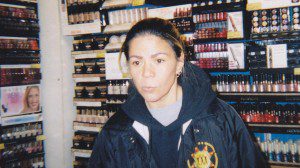Read about the Connie Oakes case here
Jorge Barrera
APTN National News
In the drabness of the interview room Wendy Scott, wrapped in a blanket, told the police interrogator it was difficult to keep things straight in her head and that sometimes it took her up to three days to piece together a puzzle.
The scene is captured in one of three segments of Scott’s interrogation video finally released to APTN National News Wednesday by a Calgary judge. The videos were played during the November 2013 murder trial of Connie Oakes, a Cree woman from Nekaneet First Nation, who was found guilty by a jury of second degree murder in the 2011 killing of Medicine Hat, Alt., resident Casey Armstrong.
Oakes maintains she is innocent and is appealing her conviction. Her appeal date is set for Jan. 12.
With no murder weapon, DNA or fingerprint evidence, the murder case against Oakes rested completely on the testimony of Scott, who was assessed as having limited cognitive abilities with an IQ of 50.
The recently released videos are from the Jan. 10, 2012, interrogation of Scott by Medicine Hat police investigators. The investigators were preparing to charge Scott with the murder of Armstrong who was found dead in the bathtub of his trailer on May 22, 2011, with a puncture wound through his neck so severe it nearly decapitated him.

Scott, who is now 30, admitted to the murder during the morning police interrogation session that day and then drove with investigators to Armstrong’s trailer, then to the home she said she was living in at the time and finally to the dumpster were she said some of the evidence from the murder was apparently dumped.
The videos depict fragments from the afternoon interrogation of Scott when she suddenly changed her story, denied involvement in the murder and blamed a third-party named “Ginger” for the killing.
Scott was being interviewed by Sgt. Jason Graham when the tale turned.
As Graham pressed her to explain why she would make up the claim of killing a man, Scott explained she suffered from extreme confusion and had a difficult time piecing events together in her mind.
“Every time I get things mixed up in my own head and that’s why, that’s why I have been in special needs because I get things mixed up in my own head. I can think one weekend I was doing this and one weekend I was doing it and getting them all mixed up,” said Scott, a slight quivering underlying her voice, according to one of three video segments released to APTN by Alberta Justice E. A. Hughes. “Sometimes, half the time, it takes me hours to figure out a puzzle…Some days it might take me three days to figure out a puzzle.”
Scott eventually pleaded guilty to second degree murder and was sentenced to life in prison with no chance of parole for 10 years. Scott’s guilty plea and testimony formed the foundation for the police and Crown’s case against Oakes.
That foundation took a hit in October when the Court of Appeal of Alberta quashed Scott’s conviction, struck her guilty plea and ordered a new trial. The decision followed a concession by the Crown handling the appeal that the evidence did not support Scott’s guilty plea for second degree murder.

Scott filed affidavits as part of her successful appeal indicating she had been assessed by a psychiatrist of having limited cognitive abilities and an IQ of 50.
Oakes’ appeal is now based partly on the October ruling and an affidavit from Scott stating she doesn’t believe the Cree woman was at Armstrong’s trailer at the time of the murder.
Scott also stated in an affidavit that she was stoned during interrogation sessions, was coerced by police and coached toward certain evidence, including the type of car used in the murder. Scott also swears that she was interrogated by police several months longer than was ever disclosed by the Crown before the cases hit the trial phase.
Scott also accused three other people—two men and a woman—of the crime.
The Medicine Hat police investigators involved in the case have denied the allegations in affidavits filed as part of the Crown’s case in the Oakes appeal.
None of the three video segments released to APTN suggest any coaching or coercion by interrogators, but they are only fragments from Scott’s questioning. The videos, which were submitted as evidence during Oakes trial by her defence lawyer Daryl Royer, do offer a glimpse of Scott’s limited intellectual capacities and contain one of the moments when she accused a third-party of the murder.
Hughes initially prevented APTN from obtaining the video segments for publishing, forcing the network to contest the decision in court. Scott’s Legal Aid Alberta-funded counsel also opposed the media publication of the video segments which were finally released following a hearing in Calgary Wednesday.
APTN is still seeking to obtain the full video interrogations of Scott, including the re-enactment of the murder which convinced Medicine Hat police and later the local Crown that Scott was involved in the murder.
The video segments, taken together with the affidavits filed by the Medicine Hat police officers, including Graham, also fill in some of the details from the final moments of the investigation that led to Scott being initially charged with murder and the solidifying of the case against Oakes.
The three segments total about 3:44 minutes from the day-long interview sessions that began at 10:25 a.m. and lasted—with breaks that included a trip to Armstrong’s trailer, the trailer home Scott believed she shared with Oakes during the weekend of the murder and a re-enactment of the crime—until 7:32 p.m.
The video segments show Scott was interviewed in two separate locations that day. According to the affidavits, Scott was interrogated at the police station and at the remand centre, which is next to Medicine Hat police headquarters. It’s difficult to determine from the videos the exact location of the interrogations.
It is also difficult to determine the exact timeline of the interrogations because the videos were released without any identification markers except that they were recorded on Jan. 10, 2012. The trial transcript also shed little light on the timeline.
The day began with Scott’s arrest at her home on Jan. 10, 2012, at about 10: 14 a.m. on the charge of obstruction. Scott had previously been questioned on Dec. 6 and Dec. 7, 2011, but released because investigators initially believed she wasn’t involved with the murder.
According to Graham’s affidavit, Scott confessed shortly after the interrogation began and said Oakes killed Armstrong with a knife.
Scott kept talking about her involvement in the murder and agreed to drive to Armstrong’s residence with the police. This would be the second time Scott was taken by the police to Armstrong’s trailer. She was taken there the previous month, on Dec. 6, but she chose the wrong house and the investigators had to point out Armstrong’s trailer, according to the transcript of Oakes’ trial.
When Scott returned to the police station for further questioning, she began to change her story and vehemently denied she was involved in the murder.
At one point, Scott admitted that she lied “my whole life pretty much.”
“Why do you like attention, especially this kind of attention?” said Graham.
“I don’t know. Psychiatrists, I really don’t know,” said Scott.
“That doesn’t make any sense to me, unless you were involved,” said Graham.
“I wasn’t, and I’ll go take a polygraph test right now. I was not there. I was not involved. I will take a polygraph test any day of the week for you. I will take 50 of them,” said Scott.
Scott then told Graham about how “things get mixed up in my own head.” Scott then stated that she woke up at about noon the day of the murder, visited with Oakes for about an hour and then took a cab to go shopping in the nearby town of Redcliff.
“Then what?” said Graham.
“Then I went home because I wasn’t feeling very well,” said Scott.
During this interview session, Graham brings up someone named “Ginger.”
“I’m telling you right now, I wasn’t there. I was not there,” said Scott.
“Did you talk to Ginger after this?” said Graham.
“No. Me and Ginger don’t really get along too well,” said Scott.
It’s in the third interrogation video, which appears to have occurred at a separate location, when Scott said the murder was committed by Ginger and Oakes.
“Who was there then?” said Graham.
“Ginger,” said Scott.
“Ginger and who?” said Graham.
“Connie,” said Scott.
Graham then presses Scott on why she would take the fall for something she didn’t do.
“Because I don’t want to put anybody, I’d rather do it, because I have been taught you don’t rat, so if I got to take the time,” said Scott.
“But you were ratting on Connie anyways when you were implicating yourself,” said Graham.
“Because we already know Connie did it, nobody knows that Ginger did it, so,” said Scott.
Ginger was the street name of a convicted drug dealer with red hair who drove a red car. An eye-witness testified in court she saw a red car in Armstrong’s driveway and two Caucasian women the weekend he was killed. The eye-witness also testified she saw a woman with red hair and wearing a ball cap put something into the trunk of the car.
The Crown prosecutor who handled both Scott and Oakes’ cases, Andrea Dolan, also had details of the red car in her files, but never submitted them as evidence. Her files indicated the red car was a Grand Am and was originally owned by a woman from Saskatchewan. APTN tracked down the woman who said she sold her car for cash and drugs to a drug dealer named Ginger, but forgot to cancel her registration.
A few months after Armstrong’s murder, Ginger was arrested and charged for trafficking cocaine. During surveillance leading up to her arrest, Medicine Hat police investigators noted she used two different vehicles, including a red Grand Am.
Medicine Hat police never found the red car in relation to their investigation into Armstrong’s murder.
Police also failed to identify the source of a size 11E bloody boot print found on the bathroom floor of Armstrong’s trailer.
@JorgeBarrera










